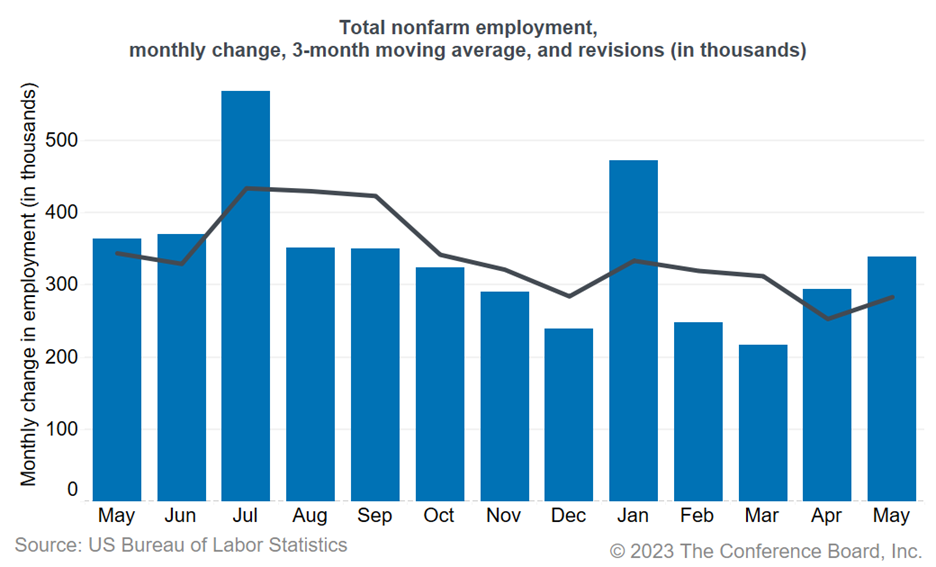Strong US Labor Market Continues to Defy Expectations
02 Jun. 2023 | Comments (0)
Commentary on today’s U.S. Bureau of Labor Statistics Employment Situation Report
Today’s jobs report revealed the US labor market remains remarkably resilient, with total employment growing by a robust 339,000 jobs in May. This follows an upward revision of April’s data to 294,000 total jobs added—another sign of the labor market’s ongoing strength. Job gains in May were economy-wide, with almost every industry adding jobs—including construction, government, health care and social assistance, leisure and hospitality, professional and business services, and transportation and warehousing.
In terms of wage dynamics, the pace of wage growth continues to moderate compared to last year but remains above pre-pandemic rates. Average hourly earnings were up 4.3 percent year-over-year in May, down slightly from 4.4 percent in April. The persistence of strong job gains and elevated wage growth, coupled with the prevailing inflationary pressures, leads us to anticipate that the Federal Reserve will take further measures to tighten monetary policy. Specifically, we project at least one more interest rate hike of 25 basis points —reflecting the inflationary pressures of continued wage growth.
Report Details
The Household Survey reveals that the unemployment rate ticked up from 3.4 percent in April to 3.7 percent in May. The change is mainly driven by an increase in the youth unemployment rate, with the unemployment rate among 16-19-year-olds rising from 9.2 percent to 10.3 percent and the unemployment rate among 20-24-year-olds rising from 5.4 percent to 6.3 percent. The latter can partially be attributed to an increase in the labor force participation rate for this age group from 70.9 percent in April to 71.5 percent in May. Still, labor force participation among 20–24-year-olds has yet to fully recover to its prepandemic level of 73.4 percent in February 2020. Meanwhile, the labor force participation rate remained stagnant at 62.6 percent, which stands 0.7 percentage points below its pre-pandemic level in February 2020.
The Establishment Survey showed that sectors reliant on in-person services continue to add jobs, with health care and social assistance adding 74,600 jobs and leisure and hospitality adding 48,000 jobs. These sectors are expected to continue their hiring efforts even during an impending recession, as the demand for in-person service workers still far exceeds the supply. Other sectors that saw significant job gains in May include professional and business services (+64,000), government (+56,000), construction (+25,000), and transportation and warehousing (+24,000).
There are a few signs of weakness revealed in today’s report, but they are mostly concentrated in specific industries. The information sector—where most tech companies sit—shed 9,000 jobs in May, bringing total 2023 job losses in the industry to 38,000. The temporary help services industry, often regarded as a leading indicator for job growth, declined by 92,000 from its peak in March 2022.
The Household Survey showed negative job growth and an increased unemployment rate in May. Layoff announcements increased by 20 percent in May compared to April, hitting 80,000 for the month and 417,500 year-to-date. This is the highest level since 2009, excluding pandemic-period layoff announcements in 2020. We anticipate that layoffs will become more prevalent across various industries going forward. Our recently developed Job Loss Risk Index identifies information services, transportation and warehousing, and construction as sectors facing the highest risk of layoffs throughout this year.
We maintain the expectation of a short and shallow recession taking hold later in 2023 as the Federal Reserve continues to implement its policy of raising interest rates to curtail inflationary pressures. Consequently, we anticipate a rise in the unemployment rate to approximately 4 percent by the end of the year and for it to reach 4.4 percent by the second quarter of 2024.

-
About the Author:Selcuk Eren
The following is a bio of a former employee/consultant Selcuk Eren, PhD, is a Senior Economist at The Conference Board. He is an experienced researcher in labor economics with a focus on demographics…




0 Comment Comment Policy